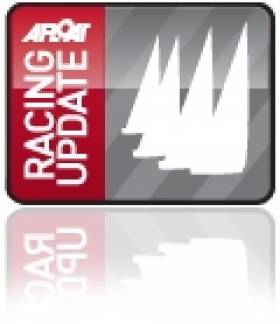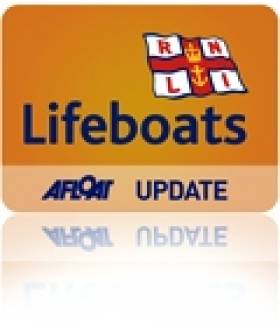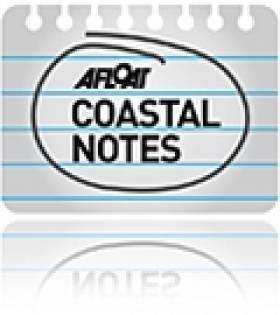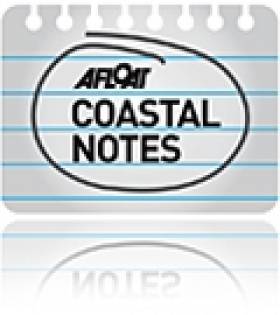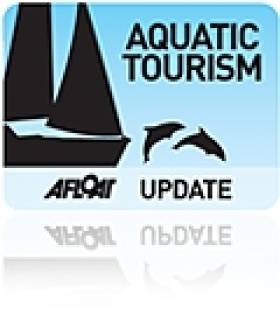Displaying items by tag: west cork
West Cork's 2014 Calves Week Sailing Regatta Opens for Entries
#calvesweek – Schull Harbour Sailing Club has opened entries for the 30th Cork Dry Gin Calves Week and will formally launch this year's regatta next week at Blackrock Castle in Cork. A regatta entry form is downloadable below as a pdf file.
Well known as a hybrid of high quality cruiser racing and shorebased family-oriented festival in the first week of August, Cork Dry Gin Calves Week has worked hard to sustain its high level of entries particularly for travelling boats over the last few years.
Club Commodore Tadhg Dwyer said that to maintain participation in the regatta over the last few years, the Club had taken the decision to rework the racing timetable in 2011. "In the end simple changes to the racing schedule meant that travelling crews are now able to sail in the same number of high quality races and get back to their home base after one week. We were also very conscious that the old format caused problems with families finding renting houses for more than 1 week very expensive and, for an event that is as much about bringing the family and enjoying all West Cork has to offer, that was a big concern. With simple changes to the overall timetable, we were able to address that."
This year, Schull Harbour Sailing Club is working to bring more travelling boats down for the week. "We have always had a mix of travelling and local boats. It would be great to get the message out to crews that might travel from clubs around the coast about the mix of both racing and on shore entertainment.
Cork Dry Gin Calves Week is great for amateur cruiser crews who want to test their racing skills against a bigger fleet and boats from around the coast. "We want to get the message out that if you come, you will have good quality racing without facing the pressure and costs of the bigger events."
For boats travelling from the South Coast, the offshore race from Crosshaven to Schull and the Calves Week Fastnet Race also forms part of the annual Scora Championship calendar.
The core format is now a four-day regatta from Tuesday to Friday of the 1st week in August, using both laid marks and the islands of Roaringwater Bay, including a race around the iconic Fastnet Rock.
As it is centred around the traditional village of Schull, there is also evening events and live entertainment around the village for both adults and children.
Dwyer noted that this year will be particularly special because it will be the 130th Schull Regatta on the Sunday after Calves Week. "There are very few sailing or sporting events in Ireland that can trace an unbroken lineage back to 1884. The Club is working with the local committee in Schull to mark this very historical event. So the week in Schull this year promises to be very, very special indeed."
Cork Dry Gin Calves Week 2014 will be announced at a reception to be held at Blackrock Castle on Wednesday the 8th of May from 6.00pm to 7.30pm. Registration forms are available on www.shsc.com.
Baltimore Sailing Keen to Welcome More National & International Sailing Events to New West Cork Clubhouse
#baltimoresc – West Cork's Baltimore Sailing Club has been redeveloped over the winter months thanks to the support of the West Cork Development Partnership and the generosity of members and local businesses.
The new club house and Comoodore Joan Collins welcomed its first event at the weekend when regular visitors, the Irish Laser Class sailed for Munster honours.
Commenting on the first event in the newly renovated facilities, Commodore Collins said: 'We are delighted to host the Lasers again. The Easter weekend in Baltimore is a stable in the Laser calendar for over 20 years and sailors of all ages from all over Ireland congregate here this weekend every year.
All the contractors worked hard to ensure that the new clubhouse was finished in time and I would like to thank Danske Bank for supporting us in our inaugural event in our new clubhouse. We look forward to welcoming more National and International events to Baltimore over the coming years.'
Baltimore Lifeboat Rescues Grounded Yacht From West Cork Rocks
#lifeboat – On a sunny Easter Sunday Morning, 20th April 2014, both the all weather lifeboat and inshore lifeboat were called upon to give assistance. A yacht had grounded on rocks at a treacherous stretch between Cunnamore Pier and Heir Island in West Cork on a falling tide. The 35ft yacht had 4 people on board at the time. The yacht was well aground when the lifeboats arrived.
The inshore lifeboat RIB crew went aboard the stricken vessel first. A line was secured to the yacht's stern and another line to the masthead. Helm Tadhg Collins on the inshore lifeboat RIB pulled on the masthead line, heeling the yacht over to reduce her draught. Then Coxswain Aidan Bushe on the allweather lifeboat towed the yacht astern to release her from the rocks on which she was wedged.The lifeboat established a tow to bring the yacht to safety. There were no injuries. Winds were fresh North North Easterly.
On the allweather lifeboat Coxswain Aidan Bushe, Mechanic Cathal Cottrell, Eoin Ryan, Ronnie Carthy, Brian MacSweeny, Sean McCarthy, Jerry Smith
On the inshore lifeboat Helm:Tadhg Collins, John Kearney, Jason Pavry
Despite Storm Damage 'Happy Baltimore' Village Turns Out to Dance
#dancingRNLI – Despite its battering at the hands of the winter storms Baltimore's maritime community made the best of things by producing an upbeat video to show how resilient the little village is.Filmed on 16th February 2014 hours after storms had ravaged West Cork - this coastal community turned out to dance. Look out for a cast of familiar faces, including a dancing RNLI Lifeboat crew.
Body Identified As Search For Missing West Cork Walker Continues
#Search - The Irish Times reports that the body recovered off Sheep's Head in West Cork earlier this week has been identified as 33-year-old Othman Rahmouni, as the search was expected to resume this morning for his friend Roland Deckers (31).
The two men, who were friends from Amsterdam, went missing almost a week ago on Saturday 8 February from the Deckers family's holiday home on the peninsula as Force 11 winds and heavy waves swept in from the Atlantic.
Emergency teams on Monday discovered a body in an inlet of the peninsula, but search efforts for the second man were hampered during the week by persistent storm conditions.
Today's break in the weather will allow for a further sweep of the northern coastline, helped by a low tide expected before noon.
The Irish Times has more on the story HERE.
Weather Hampers Search For Missing West Cork Walker
#Search - The Irish Examiner reports that a postmortem was due yesterday on the as-yet unidentified body recovered off Sheep's Head in Co Cork in the search for two men missing since the weekend.
Meanwhile an extreme weather warning for Cork and Kerry is hampering the search effort for the second of the pair, one of whom has been named as 31-year-old Dutch national Roland Deckers, whose family owns a holiday home in the area.
The other has been named by RTÉ News as 33-year-old Othman Rahmouni, a resident near Amsterdam.
Weather conditions yesterday were judged not suitable for diving, ruling out a search below the rising waves on the West Cork peninsula, and the operation has been stood down till conditions improve.
"We'd hope to get a window in the next few days, but it's not looking great weather-wise," said Valentia coastguard spokesperson John Draper.
Search Continues For Missing Man As Body Found Off Sheep's Head
#Search - BreakingNews.ie reports that a body has been found in the search for two men missing on Sheep's Head in West Cork.
The remains have not yet been identified, but are believed to be one of two visitors - a Dutch national whose family have a home near Kilcrohane, and his German national friend - who went missing on Saturday 8 February after informing family back home they were going for a walk to a nearby lighthouse.
Weather conditions on the day deteriorated quickly as Met Eireann issued one of an extended series of warnings for coastal areas.
The search continues for the second missing man, with operations co-ordinated by Naval Service vessel LE Emer, according to RTÉ News.
Pain Of Whiddy Island Disaster Remains 35 Years On
#WhiddyIsland - Thirty-five years on from the disaster at the Whiddy Island oil terminal in Bantry Bay, one of those who survived the incident has told The Irish Times how the tragedy still resonates throughout West Cork.
"The joy of Christmas doesn’t exist for me anymore," said then Gulf Oil pumpman Brian McGee, who admits he "can still vividly recall images from that night" in the early hours of 8 January 1979.
Fire broke out on board the berthed Total oil tanker Betelgeuse, causing an explosion that claimed the lives of 50 people - including locals Charlie Brennan, Tim Kingston, Denis O’Leary, Neilly O’Shea, Jimmy O’Sullivan and David Warner.
The Irish Times has much more on the story HERE.
Locals Boast About Ireland's Coast From Belfast To West Cork
#CoastalNotes - Professional snowboarder Aimee Fuller tells the Guardian about her favourite attractions around the coast of Northern Ireland.
From the new Titanic Belfast centre to the city's renowned St George's Market, the spectacular views of Belfast Lough from the top of Cave Hill, peaceful lough-side walks in Holywood and surfing in Portrush, the English pro - who moved to NI in her teens - shows there's a lot to love about her adopted home.
Meanwhile, at the opposite end of the island of Ireland, West Cork is hailed as "a perfect place to sea-kayak, relax and drink in nature", according to the Wall Street Journal - whose writer Javier Espinoza paddles out on a coastal tour with Atlantic Sea Kayaking.
Though the area is tinged with tragedy - after last year's loss of five fishermen with the sinking of the Tit Bonhomme - there is respect and admiration for the sea, especially on a calm day when kayakers can glide from shipwrecks to forests to bird sanctuaries in a single excursion.
West Cork Holiday Deserves Its Accolades
#Tourism - While angling on Ireland's waterways is undoubtedly a big attraction, there's more to this island's picturesque spots than great fishing, as Brian Gallagher of Scotland's Daily Record discovered on his recent holiday to the south-west.
Gallagher's three-day whistle-stop tour of West Cork included a meal in Ireland's 'food capital' Kinsale during the harbour town's annual arts festival, and a whale watching trip out of Baltimore that took in the rugged, lonely beauty of Fastnet Rock in the Atlantic.
Yet despite cramming a lot into his visit, he "still felt refreshed as it involved a lot of gentle sailing and tasty food.
"I have to admit this corner of Ireland, and the West Cork islands, certainly deserves its culinary title and maybe a visit… or two."
The Daily Record has more on the story HERE.


























